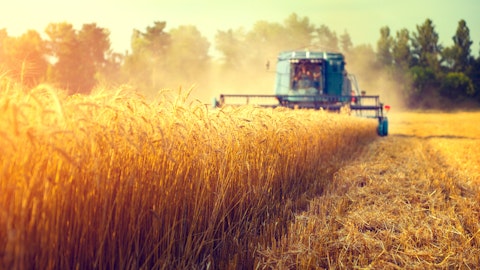Farmers’ debt-to-income ratios became unsustainable, and many farmers were unable to repay their loans. Just making interest payments was hard enough.
As a result, there were widespread bankruptcies, land values plummeted, and demand for Deere’s equipment virtually dried up.
Trying to forecast commodity markets is a fool’s errand, but it’s important to realize just how unpredictable they can be.
We don’t believe there will be another farm crisis today because farmers maintain a lower debt-to-assets ratio and interest rates are literally a fraction of what they were in the early 1980s.
On a somewhat related note, Deere also faces indirect risks from government policies that materially impact net farm income.
The 2014 Farm Bill is a government subsidy program meant to help farmers during periods of difficult market conditions. The bill is set to pay farmers close to $14 billion in 2016 (up over 30% from 2015), which amounts to about 25% of total net farm income.
Without this legislation, which is updated every five years, it’s safe to say that Deere would be experiencing even more difficult times.
Monetary policy also impacts Deere. With U.S. agricultural exports accounting for around 30% of U.S. farm income, the strength of the U.S. dollar impacts demand for U.S. crops. The export business is currently weak due to the strong dollar and weakening macro outlook in several key foreign countries.
What does all of this mean for Deere’s equipment?
Since peaking in 2013, industry sales of large agricultural equipment in America have fallen by more than 60%, and the U.S. and Canadian agricultural industry is projected to be down another 15-20% in 2016.
Deere has fared better than the overall market. The company’s sales have declined by roughly 25% from their all-time high. However, last year’s sales decline was the company’s largest percentage drop since the 1930s.
The company’s sales have rarely dropped more than two years in a row, and according to Deere’s annual report, its sales have never dropped for more than three straight years.
Deere’s markets are cyclical, but they have rarely experienced a prolonged down cycle like they seem to be facing today.
The good news is that farm cycles come and go. Demand for crops should continue rising over time as the world’s population continues growing, just as it has in the past. World demand for grain and oilseeds has increased in all but two of the past 40 years while more than doubling over that period.
Unexpected events such as a drought could also suppress industry supply to quickly lift commodity prices again. Importantly, Deere is still generating cash and making its business even stronger for the next upturn.
Investors considering Deere should remain aware of the commodity risk the business faces. However, they might also find some comfort knowing that the worst of the current downturn could be close to over (barring another low probability, high severity farm crisis type of event).
Dividend Analysis: Deere
We analyze 25+ years of dividend data and 10+ years of fundamental data to understand the safety and growth prospects of a dividend. Deere’s long-term dividend and fundamental data charts can all be seen by clicking here.
Dividend Safety Score
Our Safety Score answers the question, “Is the current dividend payment safe?” We look at factors such as current and historical EPS and FCF payout ratios, debt levels, free cash flow generation, industry cyclicality, ROIC trends, and more. Scores of 50 are average, 75 or higher is very good, and 25 or lower is considered weak.
Deere & Company (NYSE:DE) scores close to average for dividend safety. One of the factors helping the company’s score is its healthy dividend payout ratios. Despite the downturn in agricultural markets, Deere’s earnings and free cash flow payout ratios have remained solid at 44% and 21%, respectively.
Even if Deere’s profits were cut in half, it would still have enough financial strength to continue paying its dividend. Management also targets a 25-35% dividend payout ratio of mid-cycle earnings to ensure the company remains reasonably safe during unexpected industry downturns.

Source: Simply Safe Dividends

Source: Simply Safe Dividends




